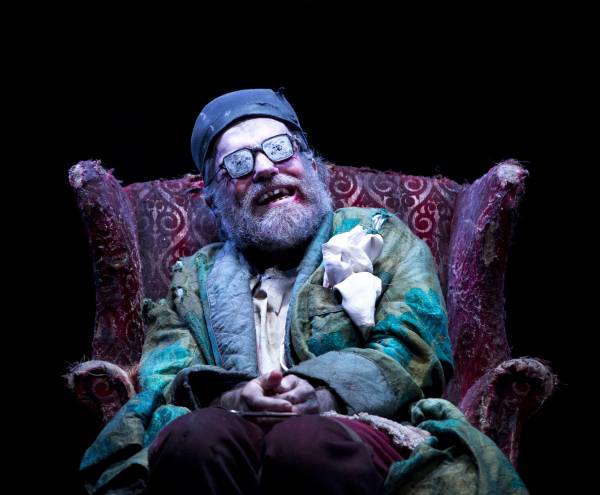Sydney Theatre Company, Roslyn Packer Theatre, April 7

In Endgame Samuel Beckett repeatedly pokes the ribs the great cosmic joke in which we find ourselves and extracts a few more crackling laughs. From the moment the play begins the end is nigh. Clov’s opening line is “Finished, it’s finished, it’s nearly finished, it must be nearly finished.” The incremental equivocation of that line sets the tone for the play as a whole. All the ragged characters know the end is nigh, all of them suspect it will be a release, but none is sufficiently certain of this that they want it to happen just yet. So, like chess players too incompetent to see that their destruction is inevitable, they delay the end: part stoicism and part numbskullism.
The problem with this performance is that they succeeded for about half an hour of real time too long.

Time and timing is everything with Beckett. In his scheme of things it is our awareness of time and mortality that makes us such pathetic blights on Creation. Timing, meanwhile, is the very stuff of comedy: the delicate mechanism that turns a smile into a laugh. When Hamm (Hugo Weaving), in one of his many observations on the action, describes it as “deadly” he was inching dangerously close to the terrible truth that this generally excellent production simply lasts too long. I have seen Endgame last less than 90 minutes, and according to the program this production was slated to run for 100 minutes. It actually lasted a full two hours.
Whether this was an opening-night aberration that shall be quickly rectified I do not know, but I do know that just when Beckett intended to tighten his noose about us with his brilliant mix of bleakness and gallows humour the play began to drag and the audience grew fidgety.
Some of the problem was built into the direction and design. In the text Beckett refers to Clov (Tom Budge) as using a “small step-ladder” to gain access to the room’s two windows. Director Andrew Upton and designer Nick Schlieper have instead placed the windows very high in the slightly conical, stone-walled set, and given Clov a full-length ladder to climb to reach them. This may amplify the humour of the opening scene, but it is a laugh that withers as the play progresses, and at a stroke adds several minutes to the length.

I suspect the rest of the time has been added largely in the duration of the pauses. This is a ticklish business, as it is in Waiting For Godot. In Upton’s production of that play (which starred Weaving as Vladimir) they struck just the right balance between stretching the pauses enough to convey the humour implicit in the tramps’ tedium, but without making that tedium extant for the audience. Here their instincts were awry, and the play has lost its natural pace.
Nonetheless Weaving is a magnificent Hamm: a ruthless despot with some stubbornly sticky evidence of a once marshmallow heart. Whether by coincidence or the sincerest form of flattery several of his lines were delivered with the exact same intonation as Michael Gambon used in the Beckett On Film production. But for much of the time Weaving’s Hamm is deliciously his own: a smarmy type of tyrant eager to forgive himself and blame the world, while nurturing an absurd kernel of hope bolstered by a native resilience.
By contrast Budge tries too hard as Clov. Often with Beckett the flatter the delivery the more the line lives. Budge’s pitch sometimes rises and falls as alarmingly as that of a boy with a breaking voice. Were he to pull back Clov’s dialogue and business it may help the play gather some of that much-needed pace.
Sarah Peirse’s Nell and Bruce Spence’s Nagg are close to perfect. They both exude that warmth of heart that makes their ashbin existences as desperately sad as they are grotesquely funny.
Where Endgame is conventionally set in a sort of bunker, Schliepper’s set conveys more of a sense of a tomb, and his eerie lighting of Nagg and Nell in their bins is a stunning effect. This is a rare chance to see one of the great plays of the last century. Just pray they up the pace.
Until March 9.
For an in-depth interview with Andrew Upton about this production see: https://johnshand.com.au/upton-on-endgame/.